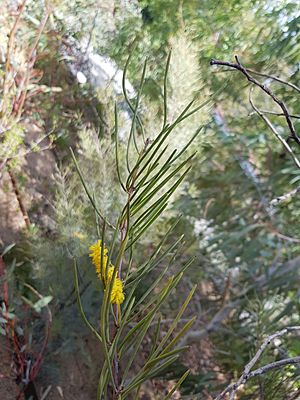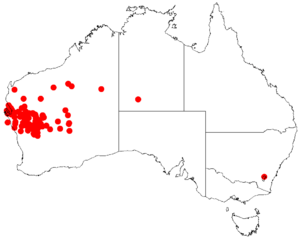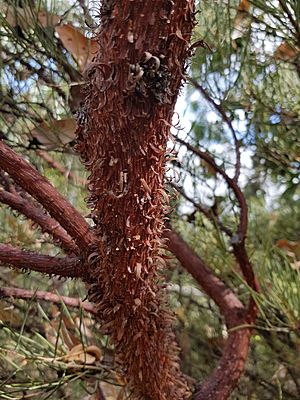Miniritchie facts for kids
Quick facts for kids Miniritchie |
|
|---|---|
 |
|
| Acacia grasbyi phyllodes and inflorescence | |
| Scientific classification | |
| Genus: |
Acacia
|
| Species: |
grasbyi
|
 |
|
| Occurrence data from AVH | |
Acacia grasbyi, also known as miniritchie, is a type of shrub or small tree. It belongs to the Fabaceae family, which includes peas and beans. This plant grows only in certain dry parts of western and central Australia.
Contents
What Does Miniritchie Look Like?
Miniritchie trees can grow from about 1 to 6 meters (3 to 20 feet) tall. They can spread out to be 3 to 5 meters (10 to 16 feet) wide. These trees often have a rounded or flat top with many branches.
They usually have several main stems. These stems are often twisted and covered in special reddish-brown minni ritchi bark. This bark peels off in small, curly flakes, which makes the tree easy to spot!
Like most Acacia plants, miniritchie has phyllodes instead of true leaves. Phyllodes are flattened leaf stems that look and act like leaves. These phyllodes are stiff and round, about a millimeter thick, and can be up to nine centimeters (3.5 inches) long.
The plant blooms between May and October. It produces bright yellow flowers that grow in cylinder shapes. These flower clusters are about three centimeters (1.2 inches) long. After flowering, the plant grows brown pods. These pods can be up to eleven centimeters (4.3 inches) long and have tight squeezes between each seed.
How Miniritchie Got Its Name
The first official description of Acacia grasbyi was made by a botanist named Joseph Maiden. He described it in 1917.
Later, in 2003, another botanist named Leslie Pedley changed its name to Racosperma grasbyi. However, in 2006, scientists decided to move it back to the Acacia group. So, its official name is still Acacia grasbyi.
Where Miniritchie Grows
Miniritchie is found mostly in the dry, inland areas of Western Australia. You can also find smaller groups of these plants in South Australia and the Northern Territory.
In Western Australia, it grows in many places. These include the Mid West, northern Wheatbelt, and Gascoyne regions. You might also see it in parts of the Pilbara and northern Goldfields regions.
This tough plant often grows on rocky hills and rises. It can also be found on stony or clay flats, and even on sandy plains. It prefers sandy red soils that are rich in iron. Miniritchie is often part of Acacia scrubland communities, which are areas with many different types of acacia plants.
Images for kids
-
Minni ritchi bark on an acacia in the Pilbara region of Western Australia
-
Acacia cyperophylla is another type of miniritchie.
See also
 In Spanish: Minni ritchi para niños
In Spanish: Minni ritchi para niños




